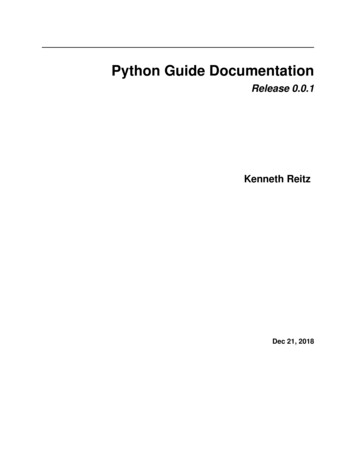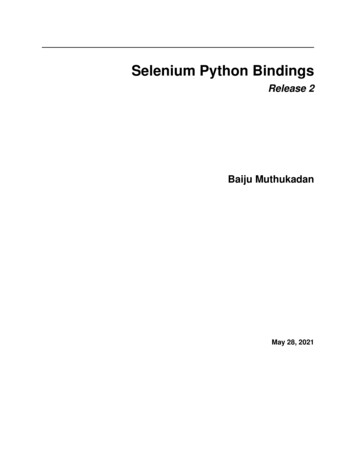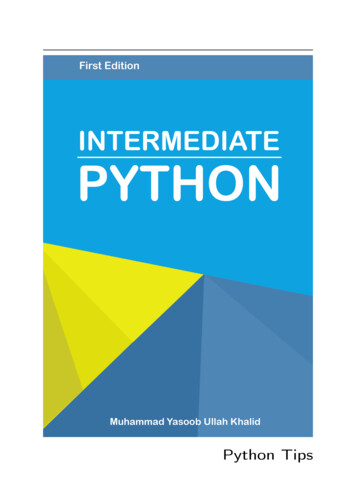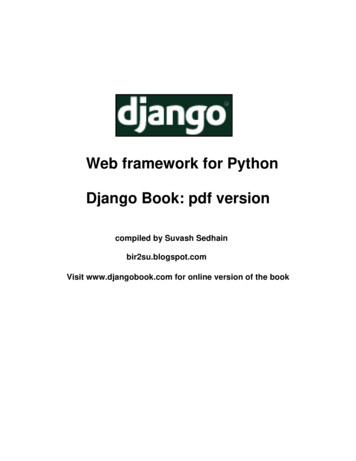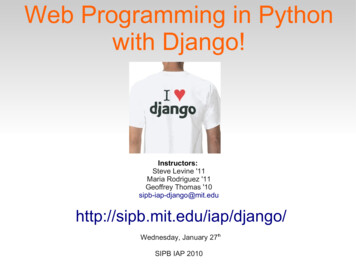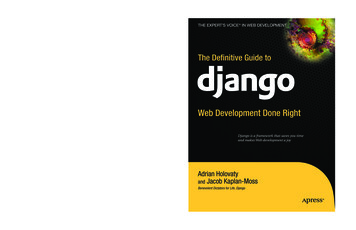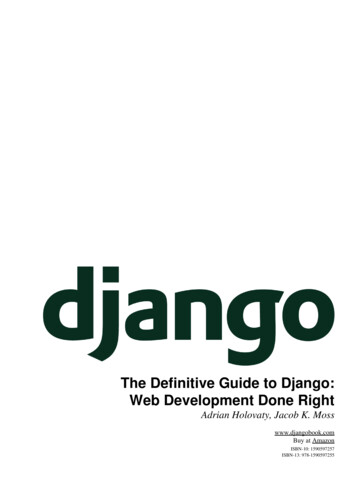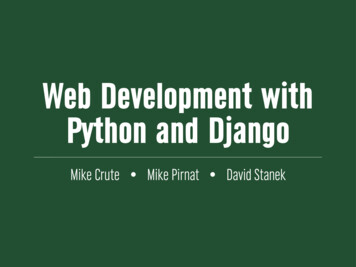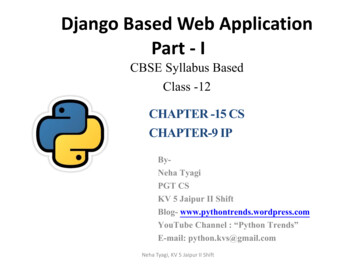
Transcription
Django DocumentationRelease 3.2.5.devDjango Software FoundationJune 04, 2021
Contents123Django documentation1.1 First steps . . . . . . . . . . . . . . .1.2 Getting help . . . . . . . . . . . . .1.3 How the documentation is organized1.4 The model layer . . . . . . . . . . .1.5 The view layer . . . . . . . . . . . .1.6 The template layer . . . . . . . . . .1.7 Forms . . . . . . . . . . . . . . . . .1.8 The development process . . . . . .1.9 The admin . . . . . . . . . . . . . .1.10 Security . . . . . . . . . . . . . . . .1.11 Internationalization and localization .1.12 Performance and optimization . . . .1.13 Geographic framework . . . . . . . .1.14 Common Web application tools . . .1.15 Other core functionalities . . . . . .1.16 The Django open-source project . . .11112223333444445Getting started2.1 Django at a glance . . . . . . . . . . . . . . .2.2 Quick install guide . . . . . . . . . . . . . . .2.3 Writing your first Django app, part 1 . . . . .2.4 Writing your first Django app, part 2 . . . . .2.5 Writing your first Django app, part 3 . . . . .2.6 Writing your first Django app, part 4 . . . . .2.7 Writing your first Django app, part 5 . . . . .2.8 Writing your first Django app, part 6 . . . . .2.9 Writing your first Django app, part 7 . . . . .2.10 Advanced tutorial: How to write reusable apps2.11 What to read next . . . . . . . . . . . . . . . .2.12 Writing your first patch for Django . . . . . .771213193137425354656972Using Django3.1 How to install Django .3.2 Models and databases .3.3 Handling HTTP requests3.4 Working with forms . .83. 83. 85. 194. 237.i
83.193.203.213.223.233.243.25456iiTemplates . . . . . . . . . . . . . .Class-based views . . . . . . . . .Migrations . . . . . . . . . . . . .Managing files . . . . . . . . . . .Testing in Django . . . . . . . . .User authentication in Django . . .Django’s cache framework . . . . .Conditional View Processing . . . .Cryptographic signing . . . . . . .Sending email . . . . . . . . . . .Internationalization and localizationLogging . . . . . . . . . . . . . . .Pagination . . . . . . . . . . . . .Security in Django . . . . . . . . .Performance and optimization . . .Serializing Django objects . . . . .Django settings . . . . . . . . . . .Signals . . . . . . . . . . . . . . .System check framework . . . . . .External packages . . . . . . . . .Asynchronous support . . . . . . 44548552555556“How-to” guides4.1 Authentication using REMOTE USER . . . . . . . .4.2 Writing custom django-admin commands . . . .4.3 Writing custom model fields . . . . . . . . . . . . .4.4 Custom Lookups . . . . . . . . . . . . . . . . . . .4.5 Custom template backend . . . . . . . . . . . . . .4.6 Custom template tags and filters . . . . . . . . . . .4.7 Writing a custom storage system . . . . . . . . . . .4.8 Deploying Django . . . . . . . . . . . . . . . . . .4.9 Upgrading Django to a newer version . . . . . . . .4.10 Error reporting . . . . . . . . . . . . . . . . . . . .4.11 Providing initial data for models . . . . . . . . . . .4.12 Integrating Django with a legacy database . . . . . .4.13 Outputting CSV with Django . . . . . . . . . . . .4.14 Outputting PDFs with Django . . . . . . . . . . . .4.15 Overriding templates . . . . . . . . . . . . . . . . .4.16 Managing static files (e.g. images, JavaScript, CSS)4.17 Deploying static files . . . . . . . . . . . . . . . . .4.18 How to install Django on Windows . . . . . . . . .4.19 Writing database migrations . . . . . . . . . . . . 34636638640Django FAQ5.1 FAQ: General . . . . . . . .5.2 FAQ: Installation . . . . . .5.3 FAQ: Using Django . . . .5.4 FAQ: Getting Help . . . . .5.5 FAQ: Databases and models5.6 FAQ: The admin . . . . . .5.7 FAQ: Contributing code . .5.8 Troubleshooting . . . . . .647647650651652653655656658API Reference.659
.286.29Applications . . . . . . . . . . . . . . . . . . . . . . . . . .System check framework . . . . . . . . . . . . . . . . . . . .Built-in class-based views API . . . . . . . . . . . . . . . . .Clickjacking Protection . . . . . . . . . . . . . . . . . . . .contrib packages . . . . . . . . . . . . . . . . . . . . . .Cross Site Request Forgery protection . . . . . . . . . . . . .Databases . . . . . . . . . . . . . . . . . . . . . . . . . . . .django-admin and manage.py . . . . . . . . . . . . . .Running management commands from your code . . . . . . .Django Exceptions . . . . . . . . . . . . . . . . . . . . . . .File handling . . . . . . . . . . . . . . . . . . . . . . . . . .Forms . . . . . . . . . . . . . . . . . . . . . . . . . . . . . .Middleware . . . . . . . . . . . . . . . . . . . . . . . . . . .Migration Operations . . . . . . . . . . . . . . . . . . . . . .Models . . . . . . . . . . . . . . . . . . . . . . . . . . . . .Paginator . . . . . . . . . . . . . . . . . . . . . . . . . . . .Request and response objects . . . . . . . . . . . . . . . . .SchemaEditor . . . . . . . . . . . . . . . . . . . . . . .Settings . . . . . . . . . . . . . . . . . . . . . . . . . . . . .Signals . . . . . . . . . . . . . . . . . . . . . . . . . . . . .Templates . . . . . . . . . . . . . . . . . . . . . . . . . . . .TemplateResponse and SimpleTemplateResponseUnicode data . . . . . . . . . . . . . . . . . . . . . . . . . .django.urls utility functions . . . . . . . . . . . . . . .django.urls functions for use in URLconfs . . . . . . . .django.conf.urls functions for use in URLconfs . . . .Django Utils . . . . . . . . . . . . . . . . . . . . . . . . . .Validators . . . . . . . . . . . . . . . . . . . . . . . . . . . .Built-in Views . . . . . . . . . . . . . . . . . . . . . . . . 1494150815137Meta-documentation and miscellany15177.1 API stability . . . . . . . . . . . . . . . . . . . . . . . . . . . . . . . . . . . . . . . . . . . . . . . 15177.2 Design philosophies . . . . . . . . . . . . . . . . . . . . . . . . . . . . . . . . . . . . . . . . . . . 15187.3 Third-party distributions of Django . . . . . . . . . . . . . . . . . . . . . . . . . . . . . . . . . . . 15238Glossary9Release notes15279.1 Final releases . . . . . . . . . . . . . . . . . . . . . . . . . . . . . . . . . . . . . . . . . . . . . . . 15279.2 Security releases . . . . . . . . . . . . . . . . . . . . . . . . . . . . . . . . . . . . . . . . . . . . . 190910 Django internals10.1 Contributing to Django . . . . . . .10.2 Mailing lists . . . . . . . . . . . .10.3 Organization of the Django Project10.4 Django’s security policies . . . . .10.5 Django’s release process . . . . . .10.6 Django Deprecation Timeline . . .10.7 The Django source code repository10.8 How is Django Formed? . . . . . .1525.19331933198119821985198819912007200911 Indices, glossary and tables2017Python Module Index2019iii
Indexiv2021
CHAPTER1Django documentationEverything you need to know about Django.1.1 First stepsAre you new to Django or to programming? This is the place to start! From scratch: Overview Installation Tutorial: Part 1: Requests and responses Part 2: Models and the admin site Part 3: Views and templates Part 4: Forms and generic views Part 5: Testing Part 6: Static files Part 7: Customizing the admin site Advanced Tutorials: How to write reusable apps Writing your first patch for Django1.2 Getting helpHaving trouble? We’d like to help! Try the FAQ – it’s got answers to many common questions. Looking for specific information? Try the genindex, modindex or the detailed table of contents. Not found anything? See FAQ: Getting Help for information on getting support and asking questions to thecommunity. Report bugs with Django in our ticket tracker.1.3 How the documentation is organizedDjango has a lot of documentation. A high-level overview of how it’s organized will help you know where to look forcertain things:1
Django Documentation, Release 3.2.5.dev Tutorials take you by the hand through a series of steps to create a Web application. Start here if you’re new toDjango or Web application development. Also look at the “First steps”. Topic guides discuss key topics and concepts at a fairly high level and provide useful background informationand explanation. Reference guides contain technical reference for APIs and other aspects of Django’s machinery. They describehow it works and how to use it but assume that you have a basic understanding of key concepts. How-to guides are recipes. They guide you through the steps involved in addressing key problems and use-cases.They are more advanced than tutorials and assume some knowledge of how Django works.1.4 The model layerDjango provides an abstraction layer (the “models”) for structuring and manipulating the data of your Web application.Learn more about it below: Models: Introduction to models Field types Indexes Meta options Model class QuerySets: Making queries QuerySet method reference Lookup expressions Model instances: Instance methods Accessing related objects Migrations: Introduction to Migrations Operations reference SchemaEditor Writing migrations Advanced: Managers Raw SQL Transactions Aggregation Search Custom fields Multiple databases Custom lookups Query Expressions Conditional Expressions Database Functions Other: Supported databases Legacy databases Providing initial data Optimize database access PostgreSQLspecific features1.5 The view layerDjango has the concept of “views” to encapsulate the logic responsible for processing a user’s request and for returningthe response. Find all you need to know about views via the links below: The basics: URLconfs View functions Shortcuts Decorators Asynchronous Support Reference: Built-in Views Request/response objects TemplateResponse objects File uploads: Overview File objects Storage API Managing files Custom storage Class-based views: Overview Built-in display views Built-in editing views Using mixins API reference Flattened index Advanced: Generating CSV Generating PDF Middleware: Overview Built-in middleware classes1.6 The template layerThe template layer provides a designer-friendly syntax for rendering the information to be presented to the user. Learnhow this syntax can be used by designers and
Django Documentation, Release 3.2.4.dev 1.11Internationalization and localization Django offers a robust internationalization and localization framework to assist you in the development of applications
